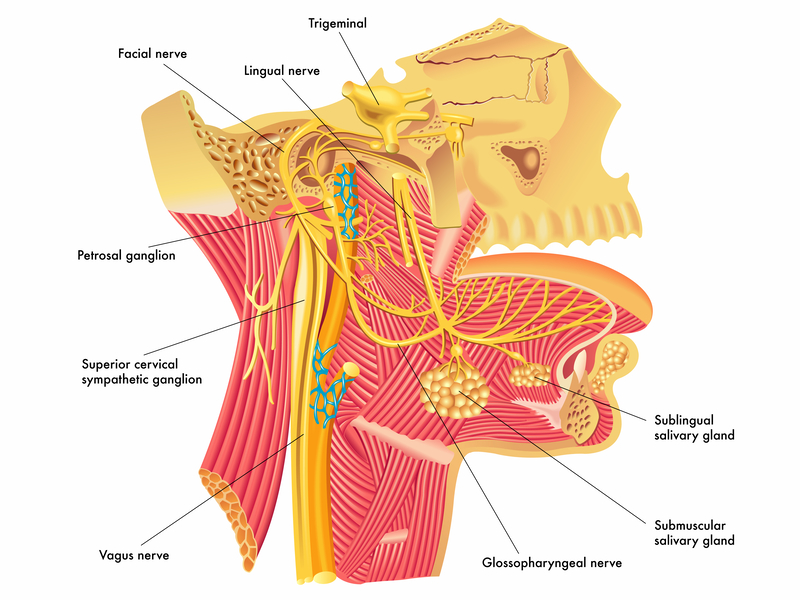We are often asked in our classes about nerve stimulation, and I wanted to discuss this topic with you as this subject if often shared throughout the sound healing community. At NEHC Academy, we feel it’s extremely important to understand the mechanisms and capabilities of the tuning forks so we can understand any limitations and expectations of working with the body’s nervous system.
I have read many articles stating the ability for either weighted and unweighted tuning forks to stimulate the vagus nerve for various purposes from activating the parasympathetic nervous system to affecting our immune system and resolving stress and depression. My concern with these articles is the way the word “stimulation” can be misinterpreted with the electrical stimulation used by medical professionals in a Peripheral Nervous System (PNS) procedure to insert an electrode next to the vagus nerve bundle to cause a change to the action potential of certain nerves within the bundle. It is important to know about the process of this particular Vagus Nerve Stimulation (VNS) to determine if our tuning forks are influencing the body in the same way.
According to the medical textbook Neuromodulation which covers all types of neurostimulation and therapeutic techniques from a clinical aspect, the VNS process is typical to other stimulation procedures designed to insert an electrode in the vicinity of a nerve bundle for the purpose of either causing or inhibiting neural activity. This concept is based primarily on the science involved in current flowing into the electrode which creates an electro-magnetic field and alters the state of the voltage-gated ion channels or proteins that are embedded in the membranes of neural elements. Most clinical applications use the same science of affecting the neurotransmitters whether to move muscles, cause the sensation of sound in the auditory system, or block the reception of pain signals. This is all about manipulating the incoming or outgoing signals (or both).
With the vagus nerve bundle transiting through the neck, a VNS will typically be applied to the left nerve bundle and the current and duration of the signal determines which nerve is going to be stimulated due to the way each nerve is constructed and the speed to transmission. Since the vagus nerve bundle includes both outgoing signals controlling things like the digestive system and incoming sensory signals like blood pressure, hunger, and nausea. The selection of the right current and duration are very important since only one aspect of the bundle needs to be stimulated or manipulated without affecting the entire system.
Now we get to the point were we discuss the ability of tuning forks to act in the same manner of electrical stimulation. First, it’s important to consider the fact that a tuning fork creates mechanical vibration and does not create either electrical current or electro-magnetic fields. The physics of tuning forks are often misunderstood to create these types of energy when we should be considering its role in the way mechanical energy affects the tissue and cells of the body. Mechanical energy cannot cause electron flow nor can it create an associated electro-magnetic field without a conversion process like piezo-electricity where putting pressure on something with this property can create an electrical current flow.
Research has shown that the body has several types of tissue capable of piezo-electric properties, but that does not necessarily translate directly to pressing a tuning fork against the bone or fascia tissue to create a specific electrical result similar to a nerve stimulation. If this was the case, we would elicit pain or cause our nearby muscles to spasm every time a tuning fork is placed on the body or held near the skin.
For the reasons stated here, I personally do not find validity to the concept of a tuning fork stimulating the vagus nerve or any nerve bundle. I do, however, know there are other factors involved with resolving nerve issues by removing the compression against the length of the nerve axons. We find with our VFRT therapy that we can greatly affect the reduction of pressurized interstitial fluid surrounding the nerve fibers and relax or resolve a fascial adhesion pinching off a nerve fiber. When it comes to the vagus nerve, our form of “stimulation” involves removing the build up of fluid in the neck which is a chronic condition in most of our clients.
Therefore, if you want to really stimulate the vagus nerve then give it a chance to operate normally without the challenges we place on our neck every time we sleep at night and put pressure on this very important part of our body. The channel of space where almost every critical vessel and nerves transits from the brain to the body.


